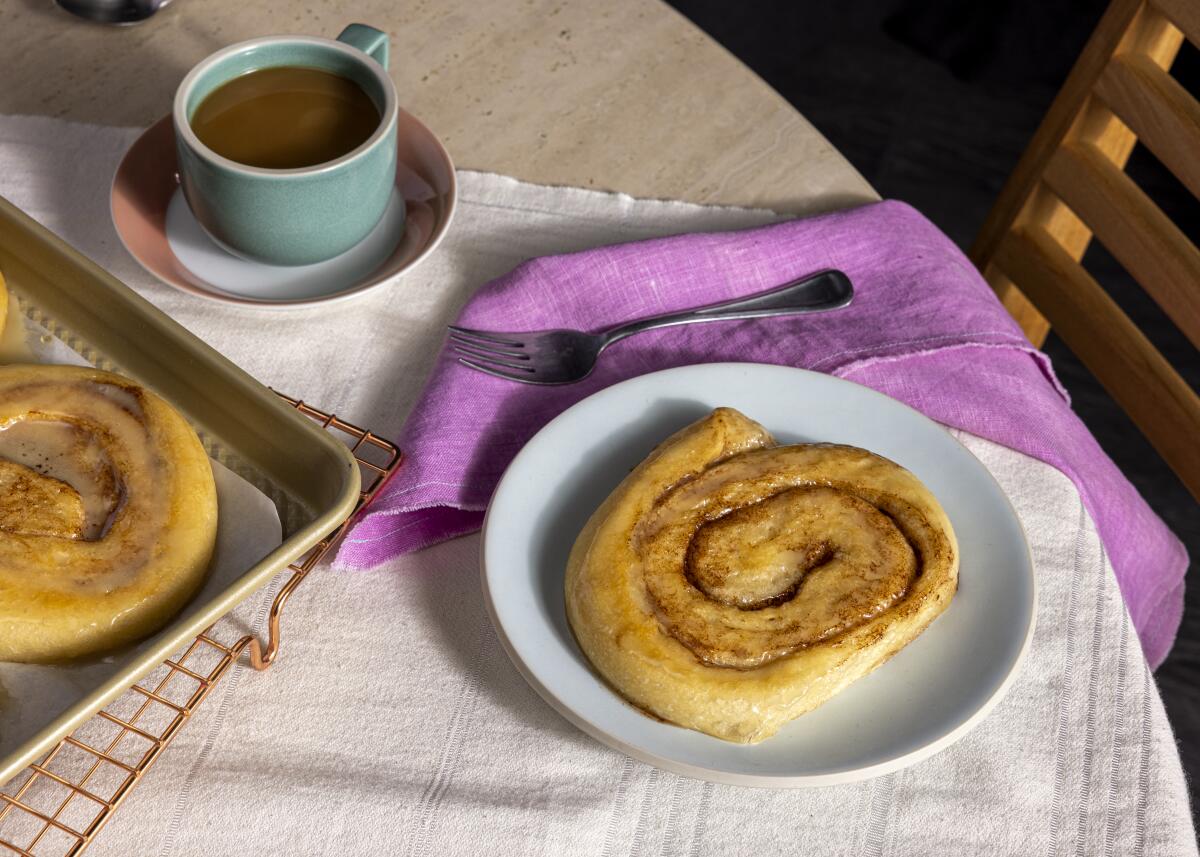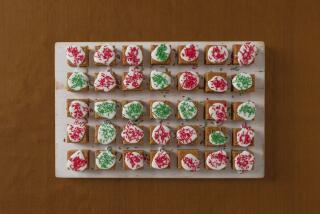Honey buns that break free of the vending machine

- Share via
Every spring when Easter time rolls around, I get the itch to bake again. Long dormant since the winter holidays, I feel prepared once more to tackle doughs, cakes and other sweet things with gusto. I always pick a new baking project to mark this shift, preferably something completely novel to me. This year, my partner expressed his desire for a homemade version of one of his favorite snacks: “Texas”-size honey buns. They’re the kind you used to get from a gas station or a vending machine in your school’s lunchroom during break period. That certainly fit the criteria for my project.
Though I didn’t grow up in the Lone Star State, I know these honey buns well. Whether called “Big” or “Jumbo,” they’re marked by a uniformly light-brown coloring and a flattened, oblong dough spiral laced with a powdery cinnamon filling. They are a mass-produced version of what was perhaps a Swedish kanelbulle — what we call a cinnamon roll — when it first came to the U.S. with Scandinavian immigrants. Along the way, cinnamon rolls became more of a crusty, white-icing-glazed mountain of dough.
Though made with more or less similar ingredients, the honey bun, by contrast, has a surprisingly thin and delicately applied glaze and less gooey filling than the cinnamon roll. However, as with most nostalgic baked goods of the post-WWII era, honey buns are laden with unpronounceable chemicals, stabilizers and artificial ingredients, which means they are ready for a makeover.
Before I started to develop my own honey bun, I read the list of ingredients on the back of their packaging to glean what is actually in the cellophane-wrapped treats. Even though I never noticed a strong honey flavor in the namesake buns, it turns out there is some — in powdered form. There is also cocoa powder in the filling, which triggered my memory of eating the vaguely bitter, powdery filling that barely laces the dough spiral.
Making a pillowy-soft dough is the easy part, since I’ve made countless cinnamon rolls in my lifetime. My go-to cinnamon bun dough uses butter but here I switched it for vegetable oil, which keeps doughs and cakes more moist than butter. I also added an egg yolk to the milk-rich dough for a little color. But to really ensure the exact pillowy texture I wanted, I turned to the Asian bread technique called tangzhong, whereby you cook a small amount of flour and liquid together before mixing it with the rest of your dough ingredients. This not only keeps the dough white-bread soft but also helps preserve the buns’ freshness for days longer. In an age when crusty, crackling sourdough is seen as the supreme dough texture, it’s refreshing to know that you can apply those same principles to a satisfyingly soft bread dough too.
With the dough figured out, I turned to the filling, which only required playing around with ratios of butter, cinnamon and cocoa powder until I hit that characteristic flavor. But I also wanted these buns to be more purposefully “honeyed,” so I added actual honey to the filling as well — some fixes are hiding in plain sight, ya know?
The biggest challenge would be to re-create the honey bun’s distinct oblong, fat spiral shape. To help with that, I use some, let’s say, “creative molding.” First, whereas for cinnamon rolls you’d roll a sheet of dough into a round spiral, I instead pleat the dough into a flat log, similar to folding a sheet of paper for an envelope.
Next, I arrange the cut oblongs on a baking sheet in a slightly crowded fashion so that when they rise and bake, they squish up against one another, further reinforcing their football form. Finally, I place another piece of parchment paper and a baking sheet on top of the buns while they proof. This may sound odd, but it provides the perfect amount of weight to keep the buns flat while still allowing them to rise and expand while baking.
For the final step in the process, I employ a common cake technique for providing moisture and a supple crumb: soaking the buns in syrup. Instead of simply glazing the buns with a powdered-sugar glaze, I make a thin syrup that gets poured over the buns as soon as they emerge from the oven. The syrup soaks in and helps to prevent any part of the buns from becoming “bready” in any way. Then, once cooled, a thicker opaque glaze is drizzled over the top and left to set up, giving the buns their iconic visage.
Surprisingly, it took about as much engineering to make my homemade honey bun as it probably did for the industrial scientists to create their packaged version. But it was enlightening and exciting to find out that you can re-create a childhood favorite — and make it even better than it was before — with just some playful maneuvering. And now, with my homemade honey buns meeting my partner’s approval, I look forward to seeing fewer cellophane wrappers lying in the car and more spent paper towels stamped with that famous swirl.
Get the recipe:
Vending Machine Honey Buns
More to Read
Eat your way across L.A.
Get our weekly Tasting Notes newsletter for reviews, news and more.
You may occasionally receive promotional content from the Los Angeles Times.












